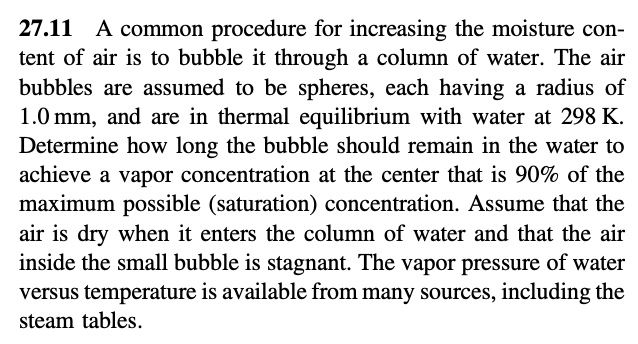27.11 A common procedure for increasing the moisture con- tent of air is to bubble it through a column of water. The air bubbles are assumed to be spheres, each having a radius of 1.0 mm, and are in thermal equilibrium with water at 298 K. Determine how long the bubble should remain in the water to achieve a vapor concentration at the center that is 90% of the maximum possible (saturation) concentration. Assume that the air is dry when it enters the column of water and that the air inside the small bubble is stagnant. The vapor pressure of water versus temperature is available from many sources, including the steam tables.
27.11 A common procedure for increasing the moisture con- tent of air is to bubble it through a column of water. The air bubbles are assumed to be spheres, each having a radius of 1.0 mm, and are in thermal equilibrium with water at 298 K. Determine how long the bubble should remain in the water to achieve a vapor concentration at the center that is 90% of the maximum possible (saturation) concentration. Assume that the air is dry when it enters the column of water and that the air inside the small bubble is stagnant. The vapor pressure of water versus temperature is available from many sources, including the steam tables.
Introduction to Chemical Engineering Thermodynamics
8th Edition
ISBN:9781259696527
Author:J.M. Smith Termodinamica en ingenieria quimica, Hendrick C Van Ness, Michael Abbott, Mark Swihart
Publisher:J.M. Smith Termodinamica en ingenieria quimica, Hendrick C Van Ness, Michael Abbott, Mark Swihart
Chapter1: Introduction
Section: Chapter Questions
Problem 1.1P
Related questions
Question
100%
Do not solve 27.11, complete these steps for the process:
a) Labeled diagram of the SYSTEM and
b) State 4 reasonable assumptions. Develop Differential Equation for Mass Transfer in terms of C A (A = water vapor within gas bubble)
c) State reasonable boundary/initial conditions

Transcribed Image Text:27.11 A common procedure for increasing the moisture con-
tent of air is to bubble it through a column of water. The air
bubbles are assumed to be spheres, each having a radius of
1.0 mm, and are in thermal equilibrium with water at 298 K.
Determine how long the bubble should remain in the water to
achieve a vapor concentration at the center that is 90% of the
maximum possible (saturation) concentration. Assume that the
air is dry when it enters the column of water and that the air
inside the small bubble is stagnant. The vapor pressure of water
versus temperature is available from many sources, including the
steam tables.
Expert Solution
This question has been solved!
Explore an expertly crafted, step-by-step solution for a thorough understanding of key concepts.
Step by step
Solved in 4 steps with 3 images

Recommended textbooks for you

Introduction to Chemical Engineering Thermodynami…
Chemical Engineering
ISBN:
9781259696527
Author:
J.M. Smith Termodinamica en ingenieria quimica, Hendrick C Van Ness, Michael Abbott, Mark Swihart
Publisher:
McGraw-Hill Education

Elementary Principles of Chemical Processes, Bind…
Chemical Engineering
ISBN:
9781118431221
Author:
Richard M. Felder, Ronald W. Rousseau, Lisa G. Bullard
Publisher:
WILEY

Elements of Chemical Reaction Engineering (5th Ed…
Chemical Engineering
ISBN:
9780133887518
Author:
H. Scott Fogler
Publisher:
Prentice Hall

Introduction to Chemical Engineering Thermodynami…
Chemical Engineering
ISBN:
9781259696527
Author:
J.M. Smith Termodinamica en ingenieria quimica, Hendrick C Van Ness, Michael Abbott, Mark Swihart
Publisher:
McGraw-Hill Education

Elementary Principles of Chemical Processes, Bind…
Chemical Engineering
ISBN:
9781118431221
Author:
Richard M. Felder, Ronald W. Rousseau, Lisa G. Bullard
Publisher:
WILEY

Elements of Chemical Reaction Engineering (5th Ed…
Chemical Engineering
ISBN:
9780133887518
Author:
H. Scott Fogler
Publisher:
Prentice Hall


Industrial Plastics: Theory and Applications
Chemical Engineering
ISBN:
9781285061238
Author:
Lokensgard, Erik
Publisher:
Delmar Cengage Learning

Unit Operations of Chemical Engineering
Chemical Engineering
ISBN:
9780072848236
Author:
Warren McCabe, Julian C. Smith, Peter Harriott
Publisher:
McGraw-Hill Companies, The